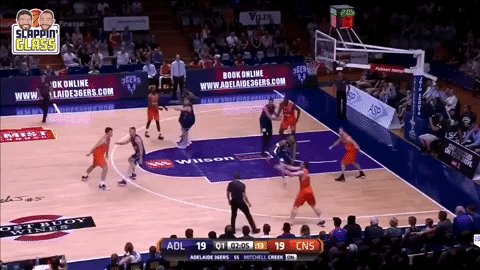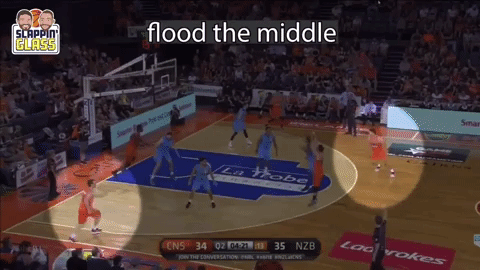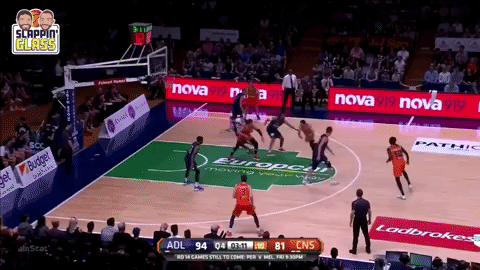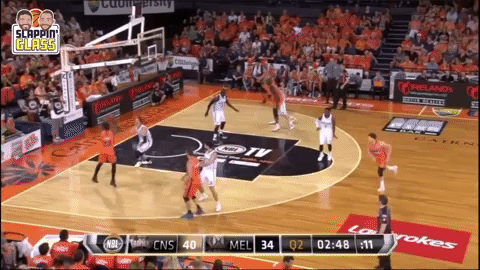🏀 "Tagging Up" Revisited
|
Exploring basketball's best ideas, strategies, and coaches around the world Happy Sunday and welcome to all the new subscribers from around the world! We hope you enjoyed the Olympic basketball as much as we have. ICYMI: Last week we looked at 12 of our favorite concepts, spacings and strategies teams are using to attack the PNR tag defender. View the breakdown HERE. This Week at a Glance:📺 SGTV: Transition Defense - Tagging Up 🎤 Slappin' Glass Podcast: Owen Eastwood 🥇Interesting Reads: Ernie Johnson's Gratitude, Setting Boundaries, and the New International Basketball Landscape Let's dive in... Tagging Up RevisitedLately, we've been thinking and talking a lot about the "Tagging Up" offensive rebounding system and felt it was worth revisiting. There hasn't been a week this summer where we haven't discussed with coaches their hopes of being a better offensive rebounding team this upcoming season, and all the benefits that go along with it. This unique "tagging up" approach, originally highlighted by Coach Aaron Fearne, has gained traction among teams worldwide, including Coach Tuomas Iisalo's Bonn and Paris squads, who have successfully adopted and adapted it in their own unique ways. As more teams continue to tweak this system to fit their personnel, it’s clear that "Tagging Up" remains a compelling and evolving strategy in modern basketball. Tagging Up: A PrimerPast podcast guest and UNC Charlotte Head Coach Aaron Fearne is highly regarded in coaching circles worldwide for his understanding and teaching of the game. In recent years, one area of particular interest in Coach Fearne’s basketball philosophy is the concept of “Tagging Up.” Below, we’ll break down the “Tagging Up” concept into three sections:
1. Tagging Up - PhilosophyTo start, Tagging Up can be defined as: A system where all five players run to the backs of their opponents on an offensive shot, driving them into the paint, and staying matched up with those players in transition defense. So, is Tagging Up an Offensive Rebounding System, or a Defensive Transition System? As Coach Fearne explains on the podcast, it’s both. For a visual, here’s a look at the major transitional phases of basketball and where the Tagging Up system fits in…
The Tagging Up system is both an offensive rebounding and defensive transition philosophy, with the rules of the system serving as a crucial link between these two phases of the game. As Coach Fearne discusses, the benefits of this system include increased offensive rebounding efficiency and extra possessions, a decrease in defensive transition baskets allowed, and an overall increase in the physicality of the team. 2. Rules and Teaching PointsWhat makes Tagging Up effective is the strict adherence to its rules. Below are some key rules, starting with the offensive rebounding aspect of the system: Tag Up on the High Side & “Scrum In” Coach Fearne emphasizes that this is one of the most important elements of Tagging Up. On an offensive shot, all five players must aggressively move toward the basket to rebound and get to the high side of their matchup. Here’s a closer look...
Coach Fearne uses the Rugby term of “scrumming” the defense into the lane when attacking the offensive glass from the High Side.
Made Shot - Transition DefenseOn a made shot, Tagging Up enables a team to quickly disrupt the opponent’s ability to inbound the ball and initiate their offense. After the shot is made, players will stay with their matchups, keeping them in front and denying easy passes to make it more difficult for the opposing team to start their offense. Missed Shot - Stay and Flood the MiddleIf all five players follow the simple rules of moving to the High Side of their tag and “scrumming” their opponents toward the middle of the key, it makes the next task—slowing down and “flooding the ball” after a missed shot—much easier and more effective. When a shot is missed, all players will stay with their tag as they transition back on defense. The player guarding the ball will stay on the ball, while the players on the strong side of the floor will sprint back to prevent any straight-line passes up the same side as the ball. The remaining players will "flood the middle," creating a wall of bodies to help mitigate any threats through the middle of the floor, whether by pass, drive, or Drag Screen.
3. Taxes and FinesLike any system or style of play, nothing is perfect and each comes with its own set of risks and rewards. We discussed with Coach Fearne the “Taxes” of Tagging Up—the costs or risks a coach is willing to accept—and the “Fines” of Tagging Up—the costs or risks that are unacceptable and could lead to failure. Let's start with the Fines, the situations that can seriously hurt your team when running the Tagging Up system. Fine #1 - Shooter Not Staying with the Closeout A common question when Tagging Up is: what should the shooter do after they release the shot? The answer: after releasing the shot, the shooter must stay with the player who closed out on them, whether it was a short closeout or a fly-by. The Fine for not doing this can be severe, potentially resulting in a wide-open layup on the other end since, unlike in most systems, there isn't a designated player "getting back" on defense...
Fine #2 - Outrunning the Coverage What if I have a great offensive rebounder? Can I let them go and chase the rebound wherever they want? Coach Fearne's answer is a firm "NO." Rules are rules, and here’s why: In the Tagging Up system, if a player outruns their matchup and doesn’t secure the rebound, they risk leaving the team at a numbers disadvantage in transition. This can give the opposing offense a significant advantage, leading to easy scoring opportunities on the other end...
Fine #3 - Running Under a Block-OutThis is where the discipline of the system becomes crucial. As tempting as it may be to slip underneath a block-out to grab a rebound, rather than always moving to the High Side, doing so can have the same consequences as the "Outrunning the Coverage" Fine mentioned above. If the offensive rebound isn’t secured, it will once again leave the opposing team with a numbers advantage in transition, increasing the risk of an easy score.
The Taxes…Though taxes are never fun to pay, they are the expected costs associated with your chosen style of play. According to Coach Fearne, here are a few of the taxes coaches must be willing to pay when running the Tagging Up system: Cross Matches in Transition: There will be plenty of instances where a defensive big closes out on a perimeter shooter, who then becomes their matchup in transition.
Offensive Rebounding Fouls: Given the overall aggressiveness and physicality of the Tagging Up system, coaches will have to accept more offensive foul calls as their team “scrums” for rebounds. Coach Fearne considers this a tax worth paying, as the benefits of extra possessions and a physical edge outweigh the risks of a few offensive fouls per game.
Tremendous Mental and Physical Effort Required: This system is not for the soft, selfish, or lazy (but then, what system is?). It demands both physical and mental effort throughout the entire game.
To complement today’s newsletter, here is our FREE breakdown video of the Tagging Up system, featuring clips provided by Coach Fearne, on SGTV. Stay tuned as we return next week with a brand new "Film Room" session featuring Coach Jimmie Oakman, where we'll explore offensive strategies for tackling "Dead Corners." Official Sponsor of "Start, Sub, or Sit?" Imagine scouting opponents, validating on-court observations, and evaluating players with just a few clicks. Our partners at Just Play's latest innovation, AInsights, empowers you to do all that, tailoring reports to your specific needs in seconds. This is more than just data; it's your personalized narrative. AInsights puts you in control, letting you curate reports that focus on the metrics most relevant to your strategy. Don't settle for generic analytics – AInsights lets you craft the information you need to gain a decisive edge. AInsights is a game-changer for coaches. It removes the analytical barrier, replacing it with a user-friendly interface and actionable insights. Whether you're a seasoned veteran or a rising star, AInsights puts the power of advanced analytics at your fingertips, allowing you to optimize your scouting, refine your game plan, and ultimately, secure victories on the court. If you are interested in learning more, go to justplaysolutions.com/slappinglass. Slappin' Glass PodcastWe rewinded on the podcast as well this week to one of our favorite episodes of all time, our conversation with one of the world's most successful and sought-after high performance coaches, Owen Eastwood. Owen is renown for his work as a best-selling author and high-performance coach. In this episode we discuss the age-old code of belonging and togetherness that can transform a team's dynamics and performance, the intricate dance of cliques and alpha personalities, along with decreasing performance anxiety and how to channel their energy towards a shared vision during the always fun "Start, Sub, or Sit?!" Listen to the entire conversation here...
Together with Hudl We're proud to partner with one of the best tech companies in the world of sports, Hudl! Every play, every stat, every breakdown. On their own, they’re essential. But all together, they’re undeniable. Hudl recently introduced their newest product, Hudl Instat – a new advanced data platform that integrates with Sportscode and every Hudl product you rely on to create an all-in-one data powerhouse. Hudl Instat’s advanced tagging and next-level stat reports help you develop your team – and its global film library helps you find the missing piece to get the most out of every second of film. Visit hudl.com/slappinglass to learn more. Interesting Reads📚 Team USA’s Thrilling Win Over Serbia Is a Preview of a New International Landscape "Getting to the gold medal game was difficult for the Americans. The gap between the USA and the rest of the world is only getting narrower." 📚 Ernie Johnson Gave a Powerful Speech About Gratitude After Winning Sports Emmy "We can all be grateful for what we do. Who in this room doesn't consider what they have a 'get to' job. I get to do this. I get to work with Pedro Martinez. I get to work with Kenny and Chuck and Shaq. So I'm grateful for that. I'm grateful I got to sit here and listen to James Brown tonight. I'm grateful for this family at TNT. 35 years I've been at this company. I get to go to work with you guys, and I'll forever be grateful for that. I'm grateful also to be in the company of Scott Van Pelt, Kevin Burkhardt, Malika Andrews - who's working tonight, Rece Davis. There's no reason for me to be standing here tonight. But I'll take it.” 📚 35 Phrases To Set Boundaries Firmly and Fairly "15. I want you to stop this behavior. I understand you are hurt/upset/angry. Let’s help you calm down, and then we can talk about it." Quote of the Week
“It's so simple, yet makes such a difference. Pretend that every single person you meet has a sign around his or her neck that says, 'Make me feel important.'” — Mary Kay Ash
Thank you for reading and have a great week coaching, Dan and Pat info@slappinglass.com We're proud to partner with the leading Sports Travel company in the basketball world, Beyond Sports! Follow the link above to learn more about why more than 600 universities have trusted Beyond Sports for their team's foreign trips. Let them know Slappin' Glass sent you! |
Slappin' Glass
Exploring basketball's best ideas, strategies, and coaches from around the world.
Exploring basketball's best ideas, strategies, and coaches around the world Happy Sunday! Welcome to all the newest subscribers from around the world! ICYMI: Last week, we explored another application of the Peel Switch, highlighting how it can be used to defend the Snake Dribble. Read the newsletter HERE. This Week at a Glance: 🏀 SG Plus Content: 2025 SGTV Most Viewed Defensive Breakdowns 🎧 Slappin' Glass Podcast: Sean Miller {Texas} 📣 Hudl Instat 📚 Interesting Reads Best of 2025...Defense...
Exploring basketball's best ideas, strategies, and coaches around the world Happy Sunday! Welcome to all the newest subscribers from around the world! ICYMI: Last week, we looked at a subtle ballscreening adjustment to create tougher overs and an easier pocket pass against the drop coverage. Read the full newsletter HERE. This Week at a Glance: 🔒 SG Plus Content: Defending the Snake Dribble - Peel Switching 🎧 Slappin' Glass Podcast: Evan Miyakawa 📣 Hudl Instat & Dr. Dish 🥇 Best of the Week:...
Exploring basketball's best ideas, strategies, and coaches around the world Happy Sunday! Welcome to all the newest subscribers from around the world! ICYMI: Last week, we took a look at those tricky deep corner inbound situations and highlighted a few concepts and actions teams are using to find success. Read the newsletter HERE. This Week at a Glance: 🔒 SG Plus Content: Ballscreen Adjustments - Tougher Overs & Late Rolling 🎧 Slappin' Glass Podcast: Evan Miyakawa 📣 Hudl Instat & Dr. Dish 🥇...






